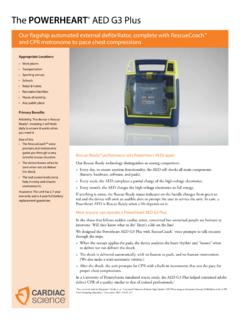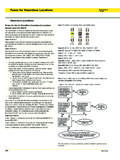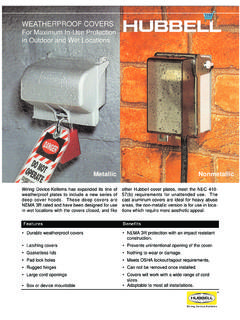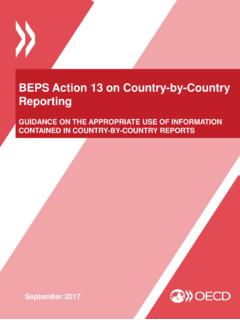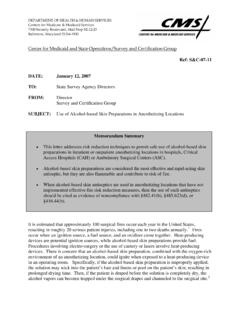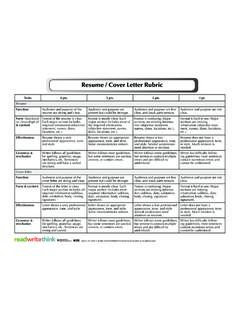Transcription of Instructions for Mapping Patient Care Locations in NHSN
1 Instructions for Mapping Patient care Locations in NHSN NHSN requires that facilities map each Patient care area in their facility to one or more Locations as defined by NHSN in order to report surveillance data collected from these areas. This document functions as a decision-making tool when determining the appropriate CDC location for NHSN surveillance, as defined in the NHSN Manual. This process should be followed when adding any new unit to NHSN for surveillance and should be repeated for any unit when there has been a significant change in Patient mix ( , merging of units, taking on a new service). Step 1: Define the acuity level for the location Is this Patient care area comprised of at least 80% of patients that are of the same acuity level?1 Proceed to Step 2 and map to a location type of that acuity level using the NHSN 80% Rule for that specific type2 Can this Patient care area be split into 2 or more Locations in NHSN for the purposes of surveillance also referred to as virtual locations3 ?
2 Proceed to Step 2 and create Locations in NHSN for each of the acuity levels, using the NHSN 80% Rule2 Map to a CDC Mixed Acuity location4 YES NO YES NO List of Acuity Levels: Adult Critical care Units Mixed Acuity Units Pediatric Critical care Units Operating Rooms Neonatal Critical care Units Long Term care Inpatient Specialty care Areas (SCA) Long Term Acute care Adult Wards Rehabilitation Pediatric Wards Outpatient (ACUTE) Locations Neonatal Wards Clinic (Nonacute) Settings Step Down Units Instructions for Mapping Patient care Locations in NHSN October 2012 2 Step 2: Define the type of service for the location YES NO Is this Patient care area a general medical, surgical, or medical/surgical unit? Or is it comprised of patients from a specific service type ( , burn, cardiac)?
3 1 If general medical or surgical, are more than 60% of patients either medical or surgical? If the unit is comprised of patients of a specific service type, does this unit meet the NHSN 80% Rule for locations2? Create a location in NHSN that is mapped to the majority type ( , medical or surgical) The mix of patients should then be a 50/50 to 60/40 mix of medical and surgical patients Create a location in NHSN that is mapped to a combined medical/surgical CDC location General Specific Create a location in NHSN that is mapped to that CDC location type Can this single unit be split into 2 or more units in NHSN for the purposes of surveillance also referred to as virtual locations3 ? YES NO Create Locations in NHSN for each of these specific service virtual Locations Is the mix of patients in this unit approximately a 50/50 to 60/40 mix of combined medical and surgical? Create a location in NHSN that is mapped to a combined medical/surgical unit YES YES NO NO Create a location in NHSN that is mapped to the location of the majority type ( , greater than 60%) - either medical or surgical Instructions for Mapping Patient care Locations in NHSN October 2012 3 Please see the CDC Location descriptions for definitions of each CDC Location used for NHSN surveillance: 1.
4 Patient mix: When determining the appropriate CDC Location Mapping for a unit, facilities should review the Patient mix in that unit for the last full calendar year. If a full year is not available, facilities should review Patient mix based on the data they have available for that unit. 2. NHSN 80% Rule: Each Patient care area in a facility that is monitored in NHSN is mapped to one or more CDC Locations . The specific CDC Location code is determined by the type of patients cared for in that area according to the 80% Rule. That is, if 80% of patients are of a certain type ( , pediatric patients with orthopedic problems) then that area is designated as that type of location (in this case, an Inpatient Pediatric Orthopedic Ward). 3. Virtual Locations : Virtual Locations are created in NHSN when a facility is unable to meet the 80% rule for location designation in a single physical unit but would like to report their NHSN surveillance data for each of the major, specific Patient types in that unit.
5 The use of virtual Locations is recommended only for those physical units that are geographically split by Patient service or those in which beds are designated by service. For example, a facility has an ICU called 5 West that is comprised of approximately 50% neurology patients and 50% neurosurgery patients . Additionally, the neurology patients are housed in beds 1 thru 10 and the neurosurgery patients are housed in beds 11 thru 20. Rather than map as a medical/surgical critical care unit, the facility decides to create 2 new Locations in NHSN: 5 WEST_N: Neurologic Critical care (10 beds) 5 WEST_NS: Neurosurgical Critical care (10 beds) This facility will collect and enter data for 5 WEST_N and 5 WEST_NS separately. The facility will also be able to obtain rates and standardized infection ratios (SIRs) for each location separately. Note that the data collected and reported for each virtual location will be limited to the designated 10 beds assigned ( , overflow from 5 WEST_N into 5 WEST_NS will be counted with 5 WEST_NS).
6 For those facilities that use an electronic source for collecting their data, we recommend that you discuss compatibility of virtual Locations in NHSN with your facility s EHR contact prior to reporting data for these Locations . 4. Mixed Acuity Unit: This location is intended for those units comprised of patients with varying levels of acuity. Because of the varying range of risk in mixed acuity units, CDC does not have plans to publish national pooled mean rates for this location type. Therefore, if your facility chooses to use this location designation for reporting, you will not be able to compare your mixed acuity unit rates to an NHSN pooled mean, nor will these data be included in any SIR analyses. NOTE: Mapping a location in NHSN to the CDC Mixed Acuity designation may have implications on data that your facility reports for the CMS Hospital Inpatient Quality Reporting Program and/or your state s reporting mandate(s).
7 Although a Mixed Acuity location may have ICU beds and ICU patients , it is not considered an ICU location type for the purposes of NHSN reporting and therefore, would not be included in any ICU-specific reporting requirements. For information about how this location designation may impact your facility s compliance with CMS HAI reporting measures, please contact your Quality Improvement Organization (QIO). For information about how this location designation may impact your facility s compliance with your state mandate (if applicable), please contact your state HAI coordinator: . Instructions for Mapping Patient care Locations in NHSN October 2012 4 Examples Example 1: An ICU that is 85% Burn patients , 15% Trauma CDC Location: Burn Critical care (IN:ACUTE:CC:B) Why? Meets 80% rule for critical care acuity level and 80% rule for specific service (burn) Example 2: An ICU that is 55% medical and 45% Surgical CDC Location: Medical/Surgical Critical care (IN:ACUTE:CC:MS) Why?
8 Meets 80% rule for critical care acuity level and does not meet the 60% rule for designation as either medical or surgical service level alone, therefore, use combined medical/surgical designation Example 3: An ICU that is 40% Neurosurgical, 40% Surgical, and 20% Medical Option 1 - Single CDC Location: Surgical Critical care Why? Meets 80% rule for critical care acuity level and does not meet the 80% rule for a specific service level alone, but when surgical patients are combined, that total does equal 80%. Option 2 - Multiple CDC Virtual Locations : Neurosurgical Critical care and Surgical Critical care , with the medical patients reported with the Surgical Critical care location since the general surgical designation is the least specific of the two Why? By splitting this unit into 2 virtual Locations , each meets the 80% rule for critical care acuity level and one meets the 80% rule for designation as Neurosurgical Critical care , while the other meets the 60% rule as general surgical service (when combining surgical and medical patients ).
9 Example 4: A unit that is comprised of 60% Medical ICU and 40% Step-Down patients Option 1 - Single CDC Location: Mixed Acuity Unit Why? This location is not comprised of at least 80% of the patients of the same acuity level and therefore meets the single location definition of a mixed acuity unit. Note that this location is not considered an ICU location type for the Instructions for Mapping Patient care Locations in NHSN October 2012 5 purposes of NHSN reporting and therefore, would not be included in any ICU-specific reporting requirements. Option 2 - Multiple CDC Virtual Locations : Medical Critical care and Step-Down Unit Why? By splitting this unit into 2 virtual Locations , each meets the 80% rule for the appropriate acuity level and each meets the 80% rule for type of service. Example 5: A pediatric ward that is comprised of 70% neurosurgical patients and 30% orthopedic patients Option 1 - Single CDC Location: Pediatric Surgical Ward Why?
10 Meets 80% rule for ward-level acuity and does not meet the 80% rule for a specific service level alone, but meets the 60% rule for general surgical service. Option 2 - Multiple CDC Virtual Locations : Pediatric Neurosurgical Ward and Pediatric Orthopedic Ward Why? By splitting this unit into 2 virtual Locations , each meets the 80% rule for the appropriate acuity level and each meets the 80% rule for type of service. Instructions for Mapping Patient care Locations in NHSN October 2012 6 Appendix: Creation and Management of Locations in NHSN Create New Locations : If there are any operational Locations in your hospital that are not already set-up in NHSN, you will need to create these Locations for the purposes of NHSN surveillance and reporting. Locations can be set up by following these steps: 1. Go to Facility > Locations . 2. On the Locations screen, enter a location code ( Your Code ) and location label ( Your Label ).











